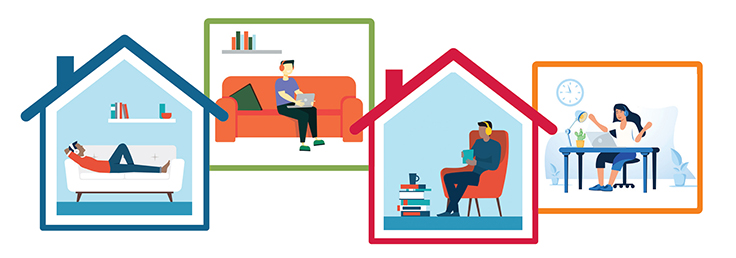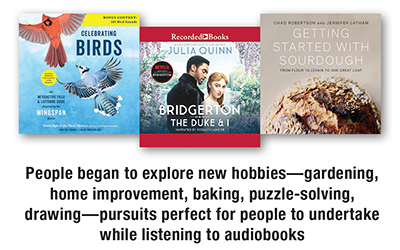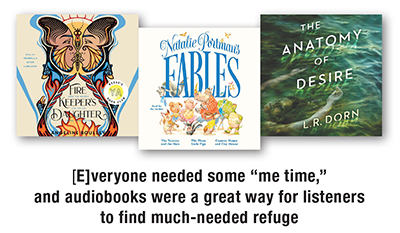Listening In Lockdown | Audio Spotlight
Audiobook publishers meet the challenges of producing during the pandemic.

The unprecedented changes wrought by the COVID-19 pandemic continue to reverberate throughout the publishing world, affecting production cycles, publication dates, delivery, and much more. The audio publishing industry has responded well, demonstrating agility and flexibility in order to meet the challenges of the past year. Creative problem-solving has allowed publishers to move past the initial shock of shuttered studios and restrictions on gatherings to ultimately post another record-breaking year. It remains to be seen what is in store for the rest of 2021 and beyond, but one thing is certain—the industry is undaunted and will continue to offer audiobooks for all listeners, no matter the circumstances.
PANDEMIC PIVOT
Audiobook publishers looked for ways to continue working when studios and entire cities closed down. Even before the pandemic, audiobook recording had been shifting to a work-from-home model as narrators set up home studios. Remote directing, editing, and proofing became more common as well. William Anderson, audiobook sales & marketing manager for Naxos of America, notes that the pandemic accelerated the trend toward remote work. This shift required creative thinking from publishers, producers, and narrators. Amanda D’Acierno, president and publisher at Penguin Random House Audio Group, shared that her team packed a “recording studio in a suitcase,” sending it to authors who recorded themselves and returned the completed recording for editing. Macmillan Audio put together five “mobile rigs’’ to travel to authors and narrators. They also worked with narrators to help them build home studios, providing virtual consultations and assisting with equipment setup. In past years, a glass wall separated narrators from producers, but now that glass wall is a computer screen.
As studios reopened, publishers adopted protocols to help keep narrators, producers, and engineers safe. Mary Beth Roche, president at Macmillan Audio, notes that changes included upgrading HVAC systems and ductwork to allow for more fresh air to circulate. Narrators still do their work in the booth, but engineers who used to be right on the other side of the glass are now working remotely. Although the publication of some books was delayed, most audiobooks released on time, thanks to the ability of publishers to accommodate new recording locations and processes for engineering and producing those recordings.
LISTENING IN LOCKDOWN
Early in the lockdown period that began in March 2020, audiobook listening plummeted. People grappled with evolving information and accommodating new lifestyles, and were too overwhelmed to listen as they once had. Commuting changed, and routines were upended while people did their best to cope. The initial downturn was concerning, but relatively brief. Macmillan Audio’s Roche says that by summertime, sales had rebounded to previous levels. Other audio publishers also noted this trend, and all saw improved numbers by June 2020.
By the end of 2020, audio sales and production had rebounded and continued the upward trajectory seen before the pandemic. Troy Juliar, chief content officer at Recorded Books, reports that RB Media and its imprints collectively produced more than 7,000 audiobooks in 2020, and the prospects for 2021 are even stronger. Juliar credits the positive sales numbers to listeners turning from commercial radio toward more curated listening, such as audiobooks and podcasts.
 RECLAIMING OUR TIME
RECLAIMING OUR TIME
Penguin Random House Audio’s D’Acierno shares that initially there were concerns that reduced commuting time might negatively impact sales and demand for audio content. They discovered that after the initial listening hiatus, listeners did return, although by that time they had changed their listening routines. For example, former commuters began to spread their listening throughout the day instead of confining it to morning and evening commutes. Listeners who were exhausted from online meetings and all-day screen time began to listen in order to relax, to get away from screens and come back to themselves. As D’Acierno puts it, everyone needed some “me time,” and audiobooks were a great way for listeners to find much-needed refuge.
LURING NEW LISTENERS
The pandemic has given publishers an opportunity to attract new listeners too. Catherine Zappa, publisher and executive vice president of film and television at Dreamscape Media, says that many entertainment options such as sports, live events, and even television and movies were paused. People began to explore new hobbies—gardening, home improvement, baking, puzzle-solving, drawing—pursuits perfect to undertake while listening to audiobooks. Audio publishers actively catered to these trends in order to connect with an already engaged base and inspire a whole new group of listeners. For example, D’Acierno remarked that the pandemic prompted a pivot towards “audio originals,” which include audio extras such as unscripted author’s notes and sidebars. One title—Getting Started with Sourdough: From Flour to Levain to One Great Loaf—was especially well received, as it was tailor-made for the many new bakers and breadmakers
Libraries also played a role in attracting new listeners to audiobooks. As libraries closed their physical locations, offering curbside service and limited access to physical materials, they encouraged patrons to check out books through digital platforms. Many libraries augmented digital collections, which inspired a new group of people to try audiobooks for the first time. Publishers suggest that their marketing strategies will reflect this new landscape in the hopes of continuing to grow the new listener base.
CHANGING CONTENT
Audio publishers report that listeners have also been seeking different types of content in the past year. Mysteries and thrillers have held strong, but many people have sought refuge in comfort reads and escapist fiction. Recorded Books’s Juliar points to the exceptional sales of Julia Quinn’s “Bridgerton” series as one example of popular fiction that offered an escape for eager listeners. Other publishers saw notable increases in science fiction and fantasy listening as well.
While some listeners sought gentle reads and escapist fiction, others turned to nonfiction. Anthony Goff, senior vice president at Hachette Audio, reports growth in nonfiction titles, especially those that center on current events. Goff noted that in response to the Black Lives Matter movement, demand surged for titles that address antiracism and social justice. Reflecting the sentiments of publishers across the board, Goff emphasized that audio publishers have long been committed to recruiting BIPOC authors, narrators, and producers, so that they can offer thoughtfully produced titles for the listening public. Inclusive and representative titles will continue to figure heavily in marketing and production efforts in the months to come.
With students learning at home, publishers saw significant gains in children’s, middle grade, and YA listening. Dreamscape’s Zappa notes that while their business has always focused on family-friendly content, the pandemic prompted the company to emphasize educational content and partnerships through audio. Publishers across the board saw similar increases in demand for content for younger audiences, with middle grade titles playing a bigger role than in previous years.
Some new trends caught publishers by surprise. Caitlin Garing, HarperAudio’s associate producer for audio production, mentioned a renewed interest in birdwatching, for example, including interest in an April release, Celebrating Birds by Natalia Rojas and Ana Maria Martinez. This book, an introduction to the joys of birding that have captivated adherents for hundreds of years, focuses on melding the hobby with the unique needs of our time. Garing says, it “sits at an interesting nexus of trends coming out of 2020: people spending more time outdoors, birdwatching, and screen-free activity that the whole family can take part in.”
 CDs IN DECLINE
CDs IN DECLINE
Production of physical audiobooks in CD format decreases year after year, but as Michele Cobb, executive director of the Audio Publishers Association, comments, this decline accelerated over the past year. Macmillan Audio’s Roche concurs, adding that publishers experienced significant problems with printing, packaging, and mailing CDs. These difficulties further complicated the CD business and made digital formats even more attractive. Currently, more than 90 percent of audiobooks can be accessed through digital platforms, and this percentage is expected to climb.
The CD business is further complicated by the lack of appropriate devices. Chris Lynch, president and publisher of Simon & Schuster Audio, notes that even if listeners have the physical media at hand, they may not have the means to play them. New cars do not include CD players, and the presence of CD players in homes is not ubiquitous. Production of discs is ceasing, which means that publishers are searching for new manufacturing sources for the titles that remain in disc format, although it is difficult to determine when CDs will be permanently retired.
Penguin Random House Audio’s D’Acierno notes that the CD business is connected to library sales. Access to library physical collections was limited over 2020, resulting in declining CD sales. Library listeners still sought out audiobooks and became increasingly comfortable with digital formats. Still, D’Acierno reassures listeners that PRH has no plans to end CD production and, as long as the company is able to do so, they will continue to produce audiobooks in whatever format listeners prefer. D’Acierno’s comments are welcome news for libraries, as they, too, are focused on providing the materials that their patrons want, regardless of format. Lorraine Butchart, collection services manager for Jackson District Library (MI), remarks that as long as their patrons continue to request CDs, the library will continue to offer them.
SILVER LININGS
Despite the many challenges of the past year, there were bright spots. The online environment has democratized casting, making the system more accessible to all. Traditional casting calls are conducted face to face, but location and travel costs are no longer barriers in a virtual environment. Naxos’s Anderson pointed out that actors were stuck at home with no theater work and few movies or television, so they were able to do more audio narration. Many publishers were able to engage celebrity narrators, even if the conditions were different than in pre-pandemic times. Macmillan Audio’s Mary Beth Roche recounts, for instance, that Natalie Portman created her own ad-hoc recording studio and narrated Natalie Portman’s Fables from the relative silence of her own closet.
The advantage of online auditions was apparent when Macmillan Audio sought Native American narrators, as the company was able to widen its call and reach out to new, authentic voices. As a result of the publicly shared casting call, Macmillan contracted with Isabella LaBlanc to narrate Angeline Boulley’s The Firekeeper’s Daughter. LaBlanc had never recorded an audiobook before, but her audition made it clear that she had the talent and authority to voice Boulley’s powerful work.
Online programs make it easier to bring authors and narrators to libraries and bookstores. Lauren Maturo, senior publicist at Blackstone Publishing, says that these events provide opportunities to connect with fans who might be unable to attend traditional events and allows for greater outreach across the country. As Maturo states, digital events are the new frontier.
HarperAudio’s Garing comments that 2020 brought a lot of technological innovations that will continue to be useful in the post-pandemic world. Full-cast recordings used to be limited to talent in a single city; now a cast can be located anywhere in the world and still create a fantastic final audiobook. An example is L.R. Dorn’s The Anatomy of Desire, which showcased a dream cast featuring Santino Fontana recording in the Pacific Northwest, Shelby Young on the West Coast, Marin Ireland in Canada, and JD Jackson in Texas.
LOOKING AHEAD
It takes more than a pandemic to push audiobooks off track. Publishers proved their ability to adapt and manage the restrictions they faced in 2020 and are poised to carry those successes into the coming years. Garing eloquently sums up the current audiobook landscape: “We all collectively experienced a major interruption to our sense of normalcy. But there is a comfort knowing that books and audiobooks are providing a place for folks, and knowing we’re a part of that.”
Sarah Hashimoto is community engagement manager for Jackson District Library, Jackson, MI. Christa Van Herreweghe is director for Kirkwood Public Library, Kirkwood, MO.
RELATED
ALREADY A SUBSCRIBER? LOG IN
We are currently offering this content for free. Sign up now to activate your personal profile, where you can save articles for future viewing









Add Comment :-
Comment Policy:
Comment should not be empty !!!